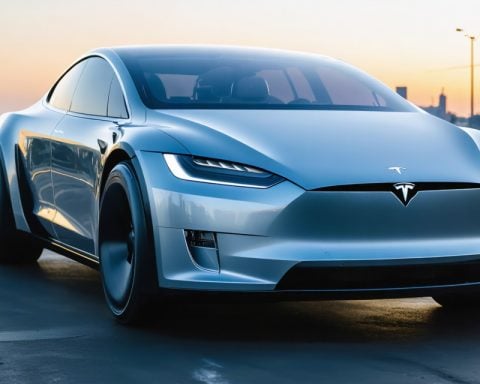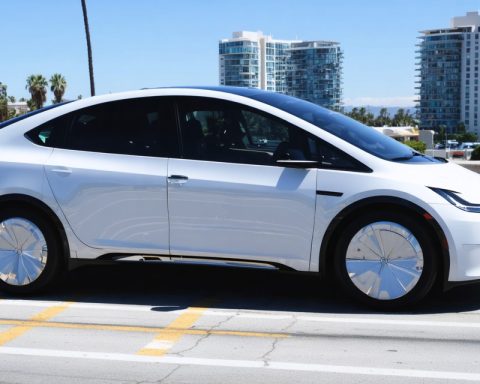- Collaborations between Waabi and Volvo are set to transform the North American freight market with AI-enhanced autonomous trucks.
- Samsung Electro-Mechanics introduces a cutting-edge MLCC, boosting reliability and performance for advanced driver systems.
- TIER IV and Nihon Kotsu in Japan are enhancing taxi services with AI, focusing on safety and ride quality in autonomous taxis.
- WeRide’s Robovan W5 offers Level 4 autonomy for efficient urban deliveries through real-time route optimization.
- Cenntro has deployed over 1,000 autonomous delivery vehicles in China, improving smart logistics and urban transport efficiency.
The world of transportation is on the brink of a groundbreaking transformation, led by powerhouse collaborations and cutting-edge innovations in autonomous vehicle technology. From smart logistics to enhanced urban mobility, here’s how companies are steering us into the future.
Unstoppable Collaborations
Waabi and Volvo are joining forces to revolutionize freight logistics. By integrating Waabi’s stellar AI into Volvo’s autonomous trucks, they aim to conquer the $1 trillion North American freight market. Set to redefine transportation, these tech-loaded trucks will commence testing in 2025, promising a safer and more efficient freight experience.
Pioneering Technologies
Samsung Electro-Mechanics has unveiled an ultra-small multi-layer ceramic capacitor (MLCC), crafted for vehicles with advanced driver systems. This innovation promises improved reliability and performance across diverse road conditions, setting a new standard in autonomous driving.
Revamping Urban Mobility
In Japan, TIER IV and Nihon Kotsu are enhancing taxi services with AI-driven solutions. By analyzing driving data, they aim to optimize safety and ride quality, ushering in a new era of autonomous taxis.
Efficient Urban Deliveries
WeRide’s Robovan W5 emerges as a game-changer in logistics. With Level 4 autonomy, it optimizes routes in real-time, boasting significant cargo space to streamline last-mile deliveries.
Scaling Smart Transport
Over in China, Cenntro has launched more than 1,000 autonomous delivery vehicles, catering to the growing demand for smart logistics and redefining urban transport efficiency.
Key Takeaway
These advancements herald a shift toward autonomous logistics, paving the way for a smarter, more sustainable future in transportation. As these technologies unfold, they promise not just operational efficiency but a complete overhaul of global supply chains. Embrace the change as the autonomous revolution accelerates into our everyday lives.
This Will Change the Transportation Industry Forever! Discover How Autonomous Vehicles Are Paving the Way
How Will Autonomous Vehicle Technology Impact the Future of Logistics and Urban Mobility?
1. Market Forecasts: Where is the Autonomous Vehicle Market Heading?
The autonomous vehicle market is on a robust growth trajectory, projected to reach a staggering value of over $500 billion by 2028. Key drivers of this growth include technological advancements, increased adoption of AI solutions by automotive companies, and the booming e-commerce sector that demands efficient delivery systems. Investments from tech giants and partnerships, like those of Waabi and Volvo, are further propelling the autonomous freight market.
2. What Innovations Are Transforming Urban Mobility?
Autonomous vehicles are reshaping urban mobility by introducing AI-driven solutions to taxi and delivery services. Companies like TIER IV and Nihon Kotsu in Japan are enhancing taxi services with AI algorithms that analyze driving data to optimize safety and ride quality. Concurrently, WeRide’s Robovan W5 has emerged as a fundamental innovation in logistics, providing real-time route optimization and cargo efficiency. With these innovations, urban environments will see reduced congestion, lower emissions, and improved transportation efficiency.
3. What Are the Pros and Cons of Autonomous Vehicles in Urban Logistics?
Pros:
– Operational Efficiency: Autonomous vehicles enable precise route planning and fuel efficiency, reducing operating costs and enhancing delivery speed.
– Safety: AI in autonomous vehicles promises a higher level of safety by minimizing human error.
– Environmental Sustainability: Reducing congestion and optimizing route efficiency contributes to decreased emissions.
Cons:
– Technology Limitations: Current autonomous systems may still struggle with complex traffic conditions and adverse weather scenarios, impacting reliability.
– Infrastructure Requirements: Successfully integrating autonomous vehicles requires significant investment in infrastructure and technology updates, which can be a substantial barrier.
– Job Displacement: As autonomous vehicles become more prevalent, there could be workforce challenges in driving and logistics sectors.
Related Links for Further Exploration
Learn more about autonomous vehicle technology and its impact on global markets:
– Waabi
– Volvo Trucks
– Samsung
– TIER IV
– WeRide
– Cenntro
The landscape of transportation is poised for significant transformation as advancements in autonomous technology continue to accelerate. Embrace these developments as they promise a safer, more efficient, and sustainable future in logistics and urban mobility!

















